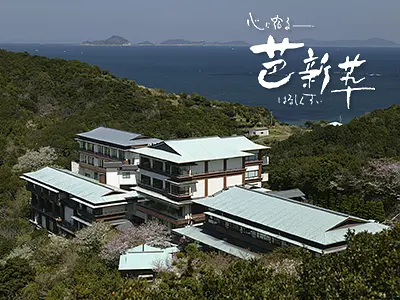“海女”文化に触れる!海女小屋で伊勢海老やアワビなど海の幸を堪能!
掲載日:2021.11.20
海女とは、海に潜り海産物(貝や海藻類など)を採る職業の女性のこと。今回は海女小屋体験施設「さとうみ庵」での体験を通して、海女文化をご紹介!施設では新鮮な海産物や伊勢えびまでいただけちゃいます。海女小屋体験、レッツスタート!
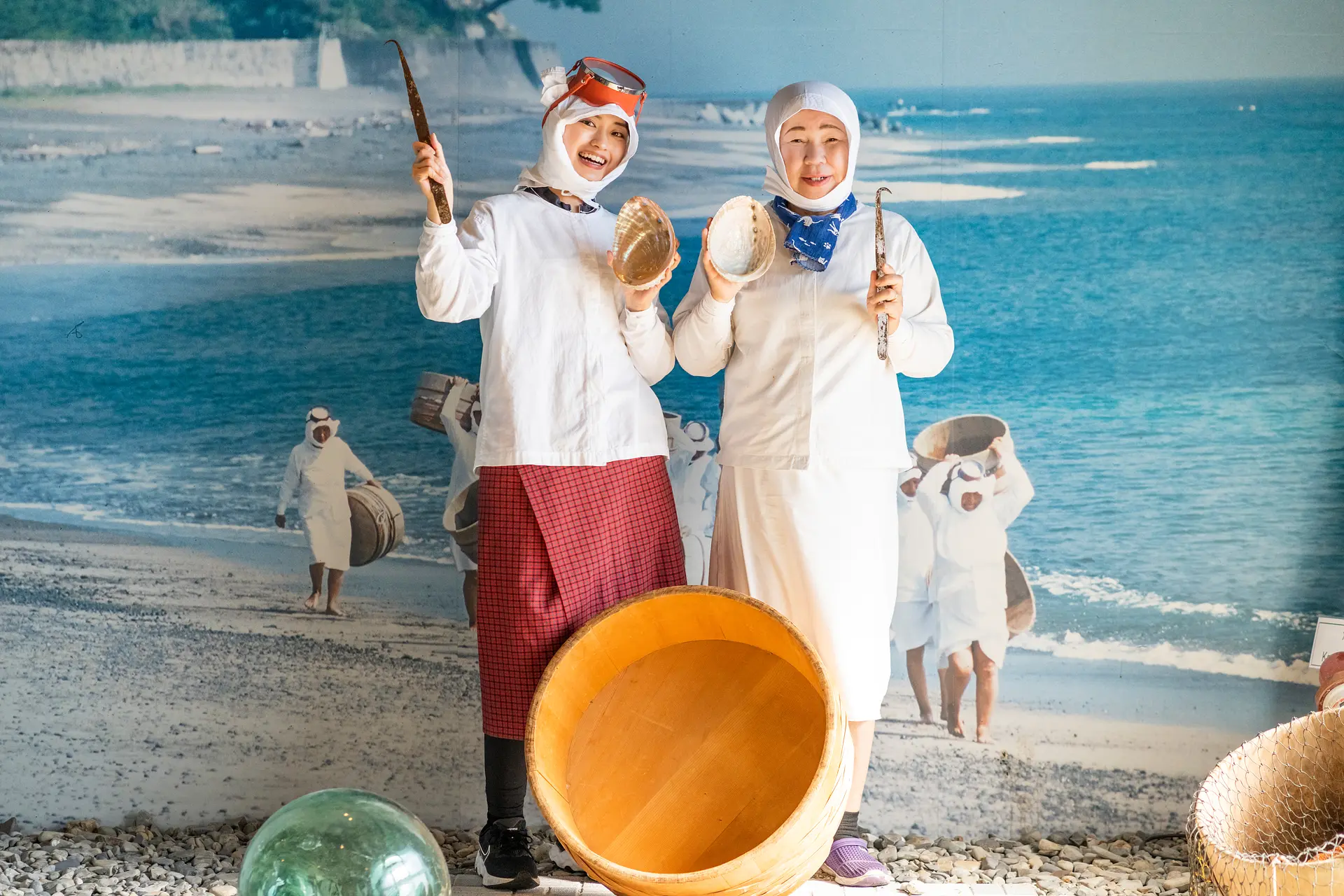
YouTube動画や観光三重の特集記事にて"みえ旅"の魅力を発信する【みえ旅YouTube隊】に、元自衛官タレントかざりさんが特別派遣隊員として入隊!今回の任務は「海女文化に触れる!」。体験の様子はYouTube動画でも配信中♪詳細は記事の下部をご覧ください。
■目次
- 1.海女とは
- 海女について
- 海女の種類
- 海女が使うもの
- 2.海女小屋で伊勢志摩の海産物をいただきます!
- 海女さんが採る新鮮な海産物について
- 海女小屋にて、海女さんが目の前で網焼き!
- 伊勢えび漁、解禁!
- 3.本物の海女さんにいろいろ聞いてみよう!
- 林さんの海女歴
- 海女が少なくなってきている
- 4.最後に海女の服、磯着を着てみよう!
- 5.海女小屋体験施設さとうみ庵へのアクセス
1.海女とは
海女について
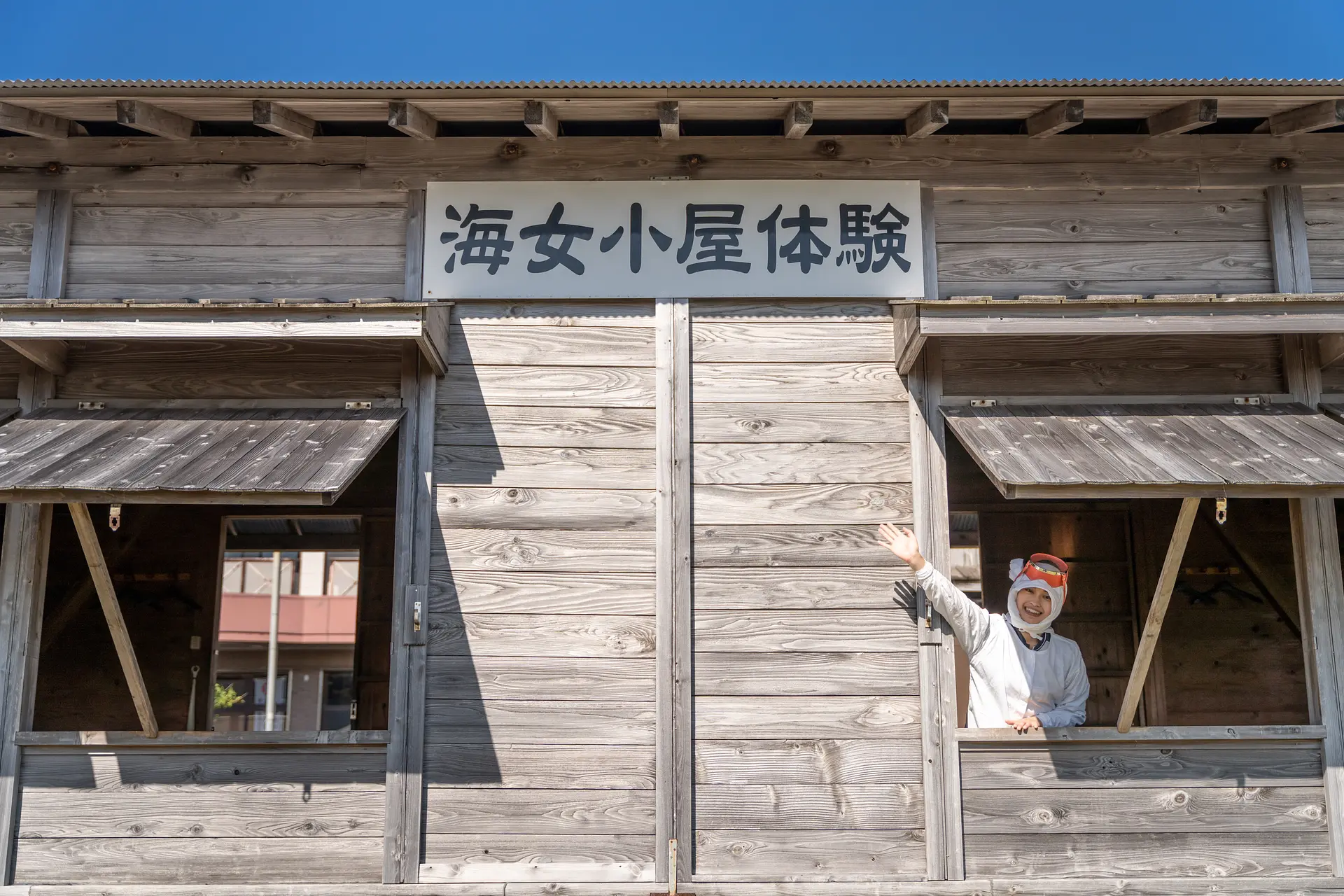
「海女」は 海に潜り海産物を採る職業の女性を指します。現在、全国の海女さん(1,300人ほど)のうち、約半数が伊勢志摩にいるそう。ちなみに…「海女」と一口に言っても、作業の仕方によって呼び名が変わることは、ご存知でしょうか?また、どんな道具を使って、どんな海産物を採っているかなどなど…本記事では、海女文化について、海女小屋体験施設さとうみ庵での体験を通して、ご紹介していきます!海女について楽しく学んでいきましょう♪
海女の種類
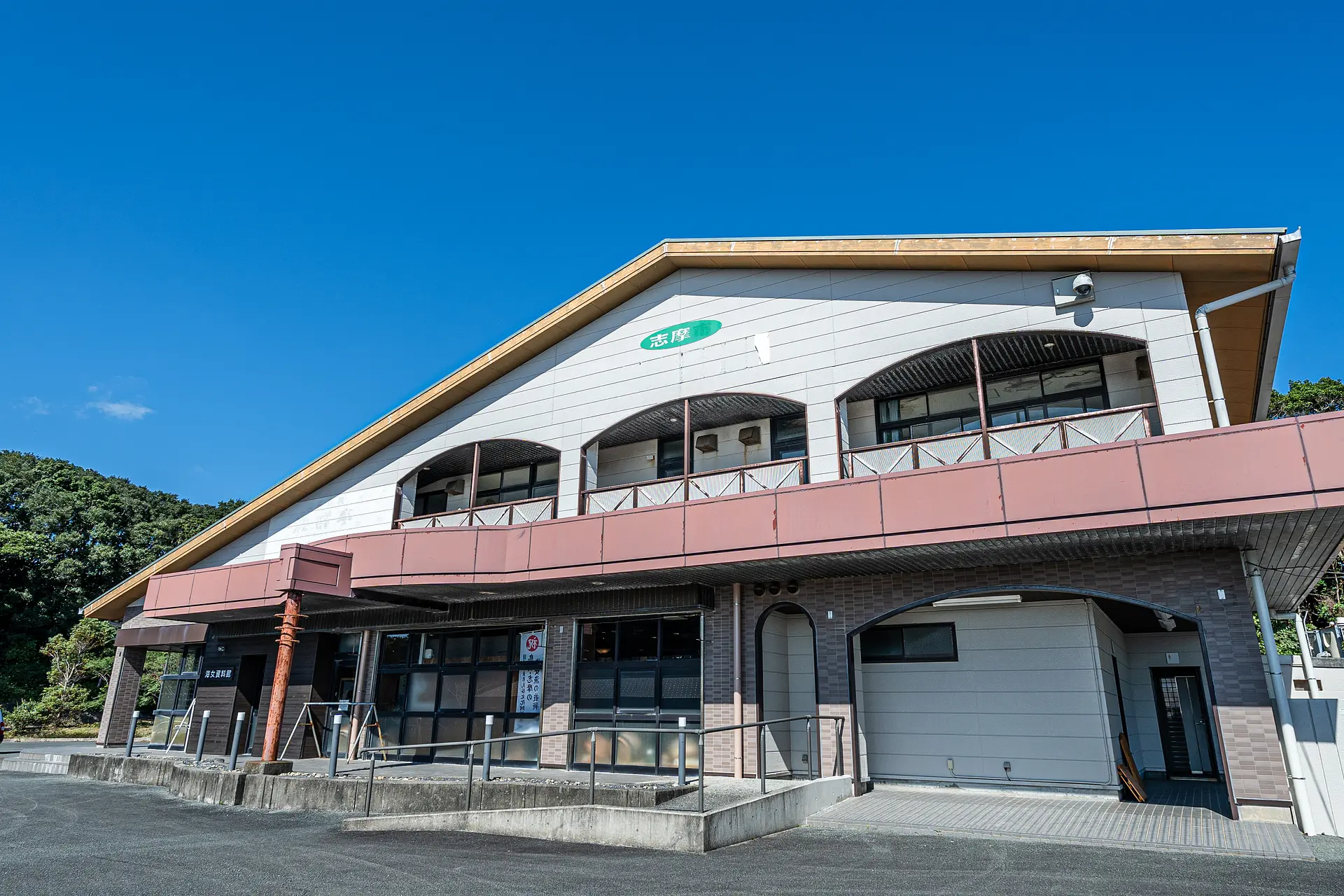
さとうみ庵の海女資料館では、海女の文化・歴史について詳しく知ることができます。資料館で展示されているものから、いくつかピックアップしてご紹介!まずは海女の「種類」についてみていきましょう。
1人で作業する海女は「カチド(徒人)海女」
1人の海女さんが、桶や浮き輪につかまって岸から磯場まで泳ぎ作業する場合は、「カチド(徒人)」と呼ばれます。カチドは、主に海の浅い場所(約4~10m)で作業をするそう。「浅い」といっても4~10m…。素人からすると、「途中で息が切れたらどうしよう」と、十分怖くなる深さですね(ブルブル)。カチドのほかに「オヨキド」「ハマコ(浜子)」「コイソド(小磯人)」「イタアマ(板海女)」「カカリ」「オケド(桶人)」などといった呼び名もあります。
2人で作業する海女は「フナド・フネド(舟人)海女」
2人で潜水作業をする場合は、「フナド」「フネド」と呼ばれます。フナドは、最も深い漁場(約15~20m)で作業をします。特に夫婦で作業をする船の場合は「トトカカ船」「メオト船」と呼ばれるそう。海女が縄をもって深く深く潜り、狙ったものが採れたら縄を通じて合図を出し、補佐をする側(夫など)である「トマエ(徒前)」が海女を海面まで引きあげます。お互いが信頼していないと絶対にできない仕事ですね…めちゃくちゃかっこいいです。フナドのほかに「オオイソド(大磯人)」「ギリ」「オオカツギ(大替ぎ)」などといった呼び名もあるそうです。
海女が使うもの
海女さんが海で作業するにあたって使うものは、どれも特徴的なものばかり。いくつかをご紹介します!
海女着
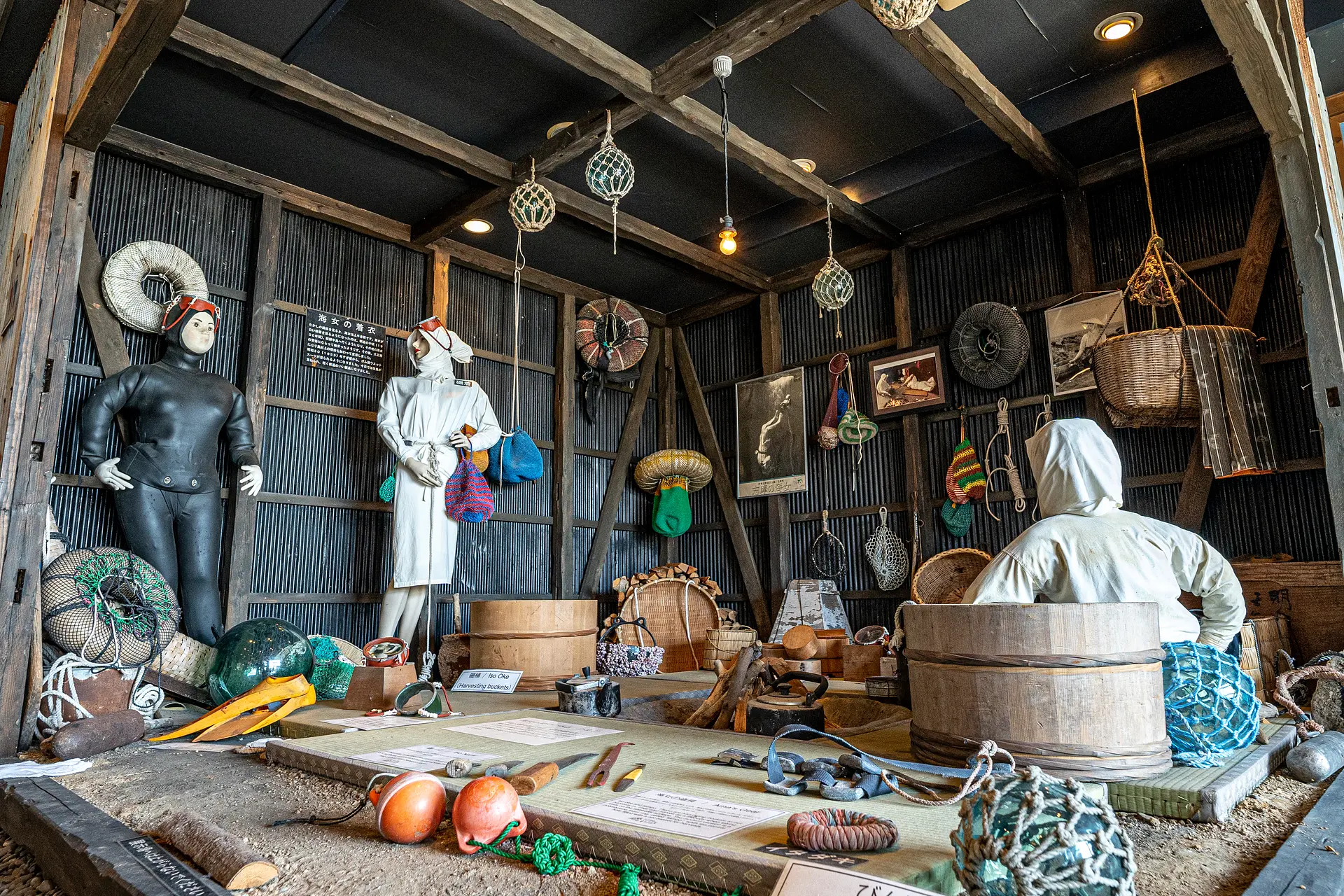
海女着というと、白い衣装「いそぎ(磯着)」を思い浮かべる方が多いかもしれません。実は、海女さんたちが磯着を着ていたのは1955年頃までで、以後はウエットスーツが主流となりました。歴史をさかのぼると、1898年頃まで、何と上半身裸で潜っていたそう。海女さんは1日に何十回と海に潜るのですが、ウエットスーツを着ていたとしても寒くて大変なのに、裸や薄い磯着で仕事をしていたなんて…相当タフじゃないと出来ないですよね!
磯メガネ
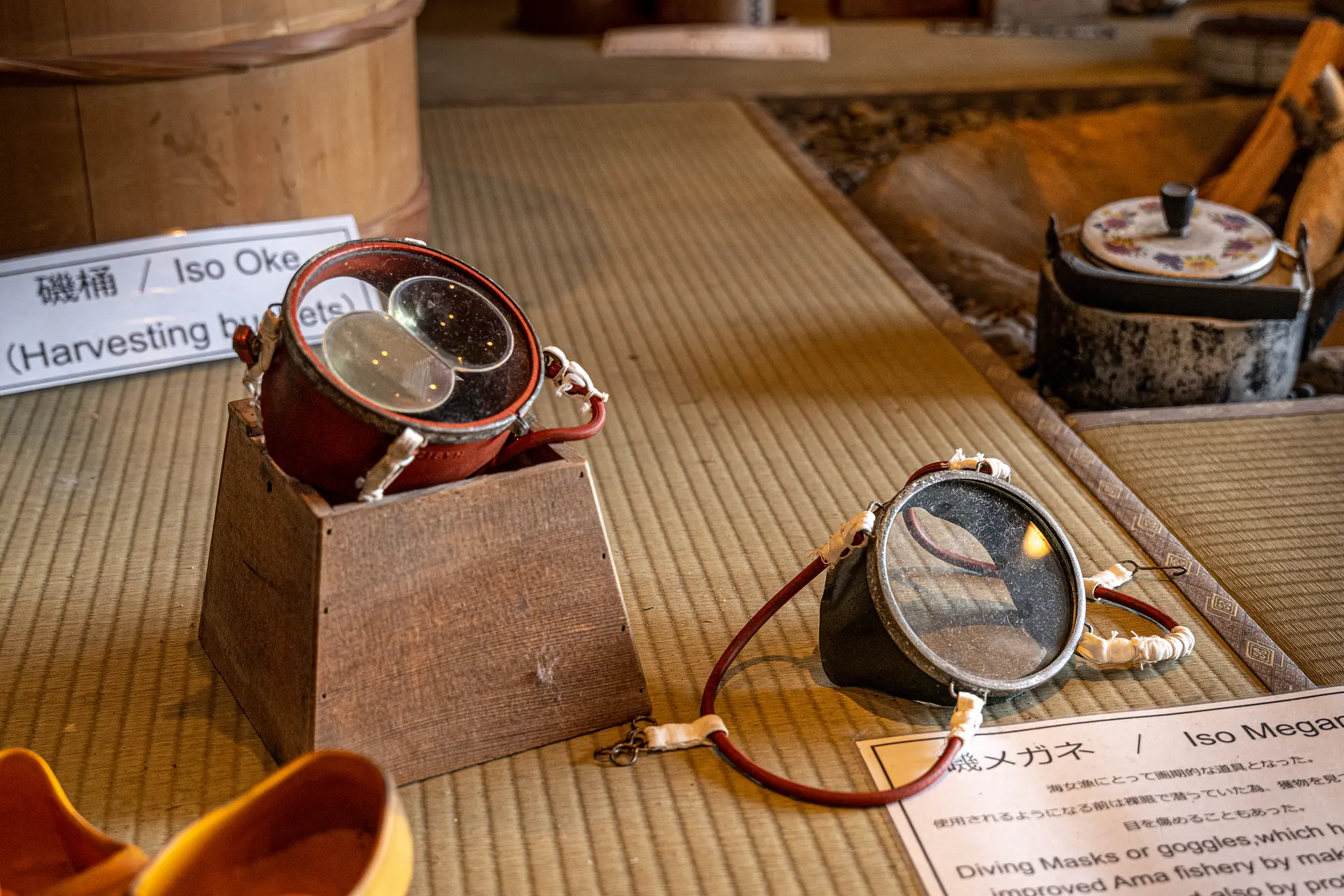
これまた驚きなのですが、明治初め頃まで、海女さんたちは磯メガネなどを付けずに潜り、海産物を採っていたそうです。磯メガネを付けるようになると、「採れすぎ」る状況が発生し、磯メガネが禁止される時期もあったそうですが、明治末には再び使用できるようになったとのこと。海女さんたちは現在でも磯メガネを使用して海に潜っています。とっても大事な仕事道具のひとつですね。
磯桶
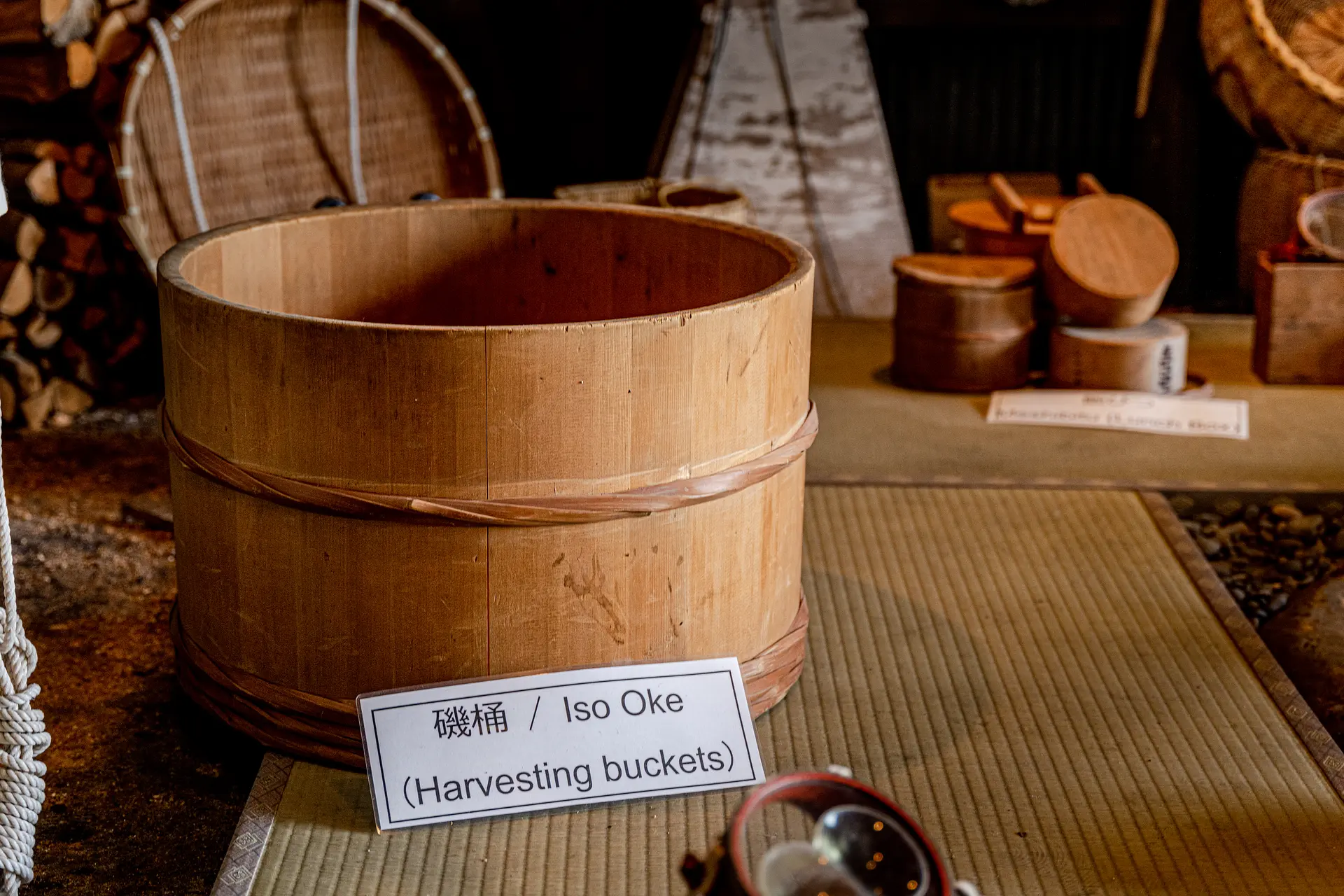
大きな磯桶は採った海産物を入れるためのもの。1日の仕事で30回、40回と海に潜り、獲物を捕ったら水面に浮く磯桶に入れていきます。大きな磯桶に、新鮮な海の幸がどんどん入っていく様子を想像すると、ワクワクしますね。
おもり
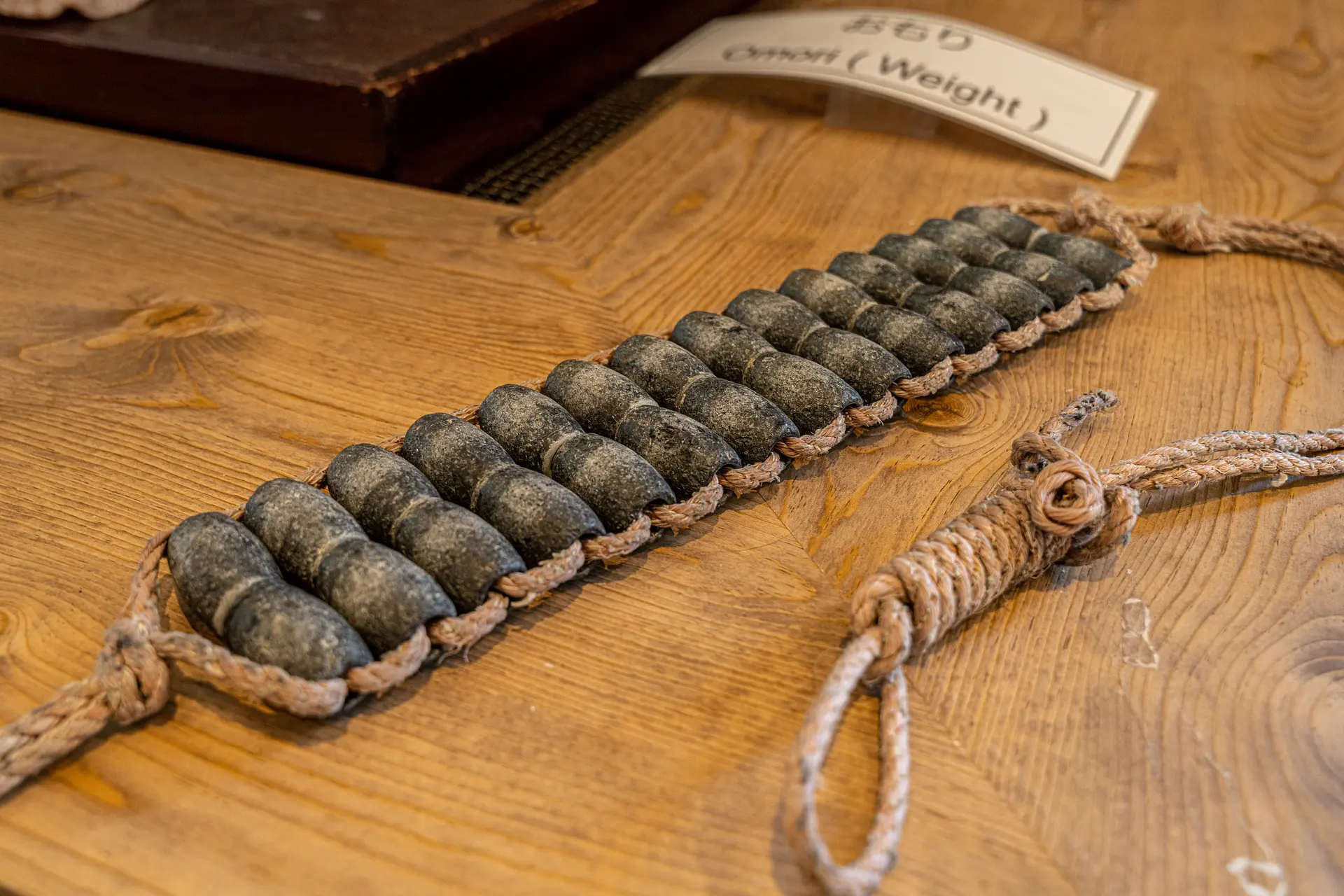
自重だけで海に深く潜るのは至難のわざ。海女さんはおもりを腰に巻き付けて海へと潜ります。
磯ノミ
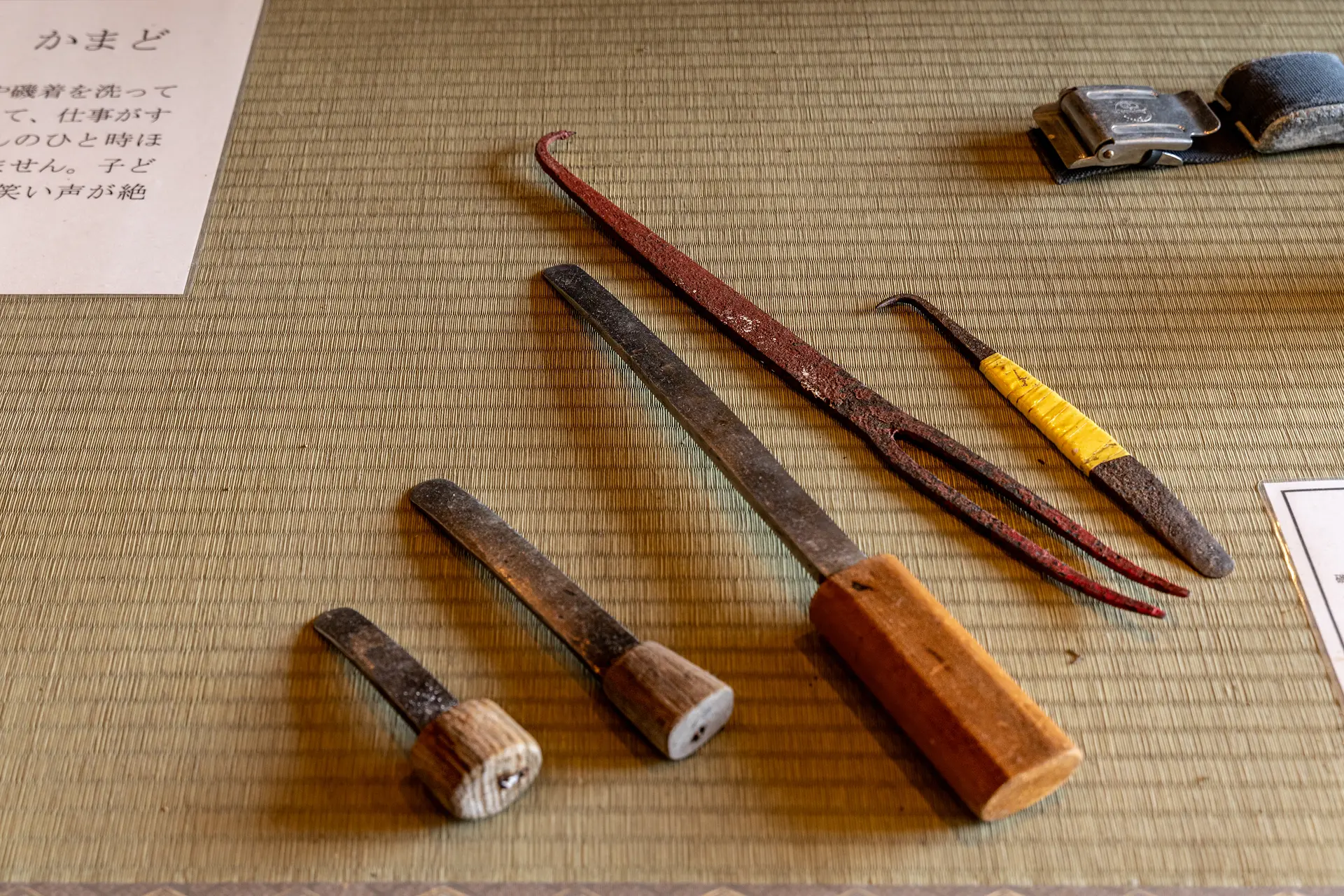
岩からアワビをはいだり、岩の間にいるサザエやウニを掻き出す際に使う磯ノミ。海女さんたちはこの道具をうまく使いこなし、するっと一発で海産物を採りますが、素人だとなかなかうまく採れないそう。プロ専用の道具ですね。
海女小屋のかまど
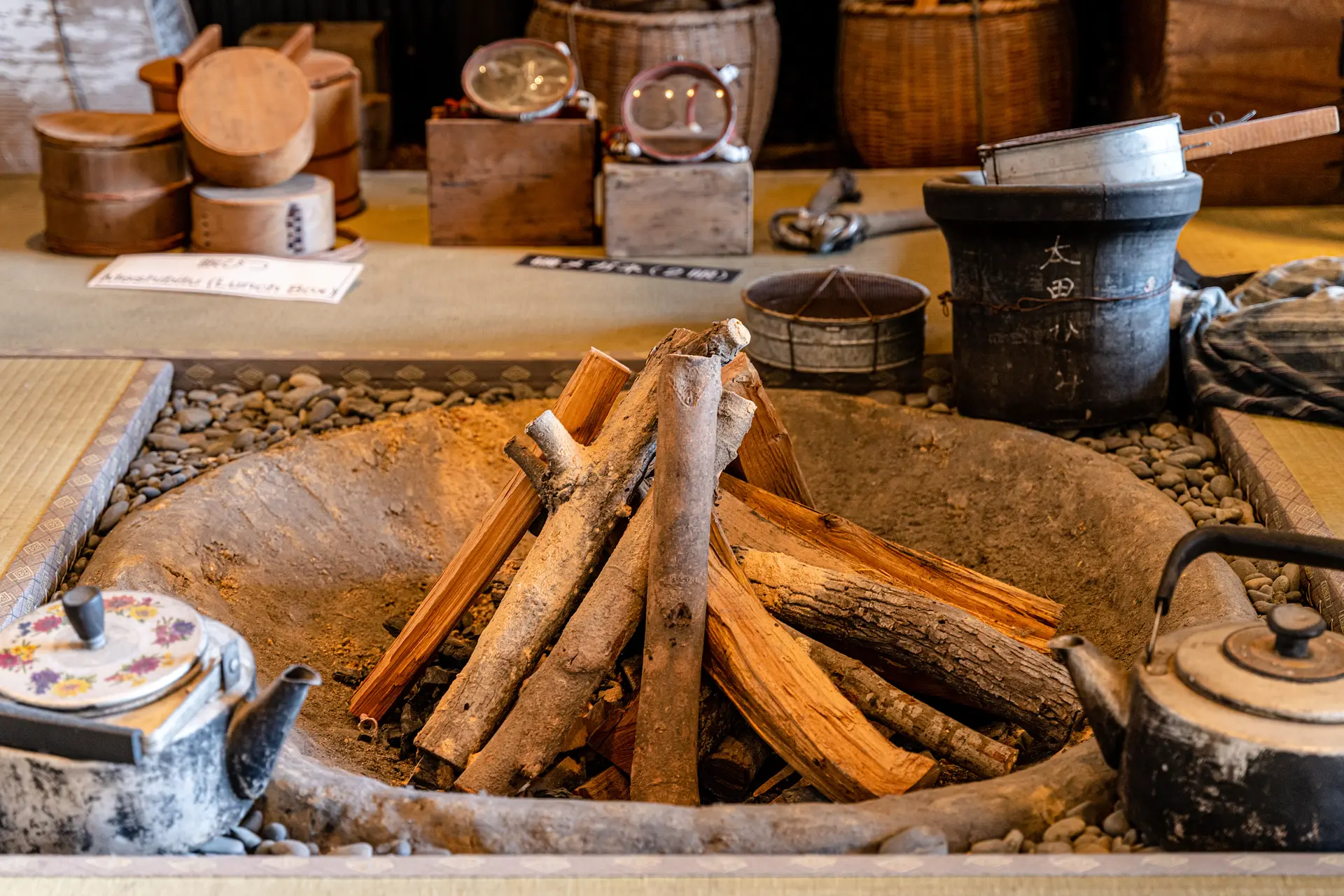
海女さんたちの憩いの場、「海女小屋」。海女小屋の中にある「かまど」は、海中で冷えた海女さんたちの体を優しく温めてくれる大切な場所です。早い時間から何十回も海に潜って海産物を採り、それを市場へと運んだあと、かまどを囲んで海女仲間たちと団らんのひと時を過ごす…。そんな様子を想像するだけで、なんだか暖かい気持ちになりますね。
2.海女小屋で伊勢志摩の海産物をいただきます!
海女さんが採る新鮮な海産物について
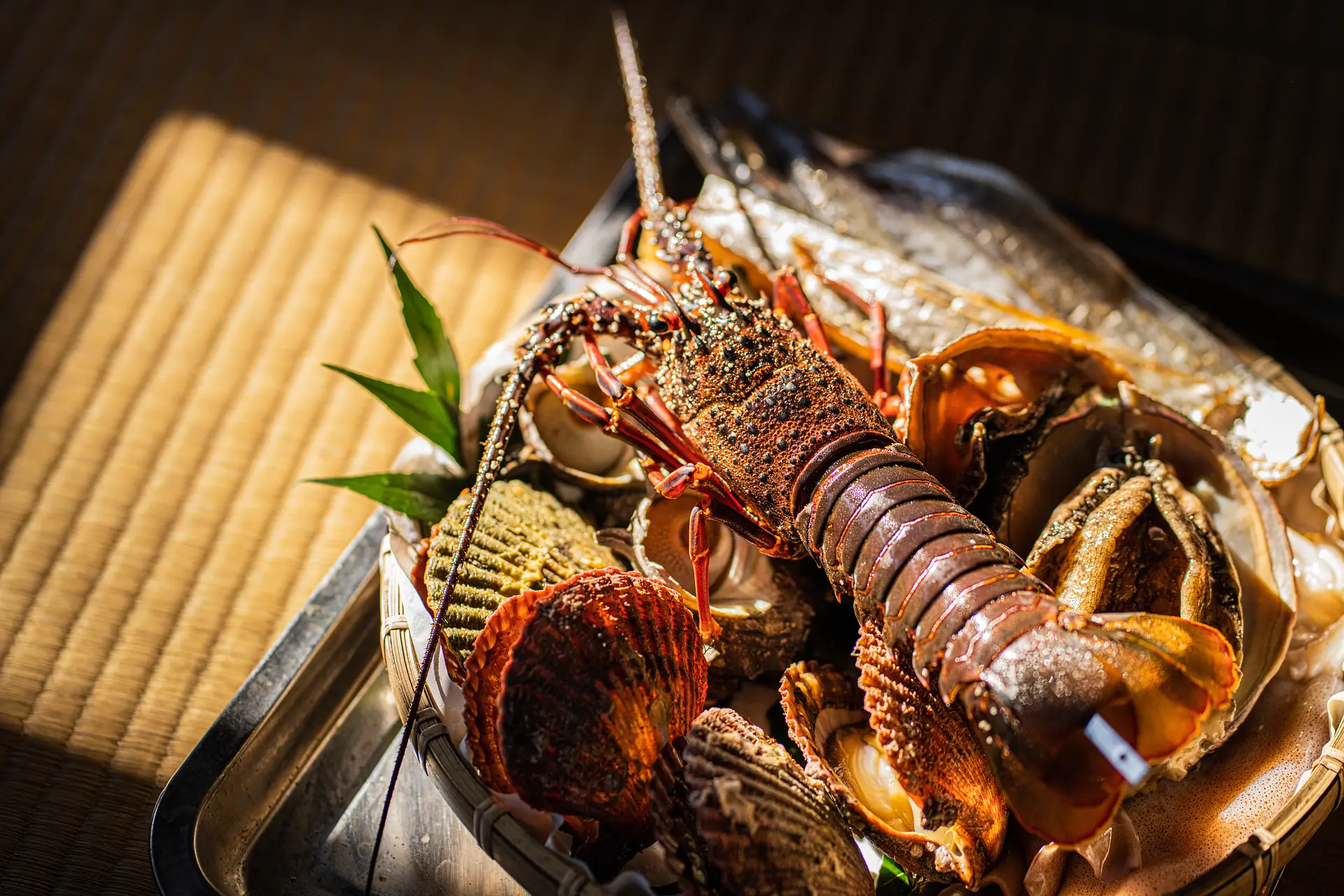
海女さんが採るものというと「アワビ」が真っ先に思い浮かびますよね。水深7mから深くて20mのところに生息するアワビを、海女さんたちは長い時間潜って探します。想像するだけで途方もない作業です…。アワビの他にも、サザエや海藻類、伊勢えびまで、豊富な種類の海の幸を、海女さんたちは採っています。
今回、海女小屋体験施設さとうみ庵では、伊勢えび、アワビ、桧扇貝(ヒオウギガイ)、さざえ、スルメイカ、干物をいただきます!そのほか磯の香りを満喫できるアオサのお味噌汁と、ひじきの釜めしも味わえます。海の幸を思う存分、堪能しましょう♪
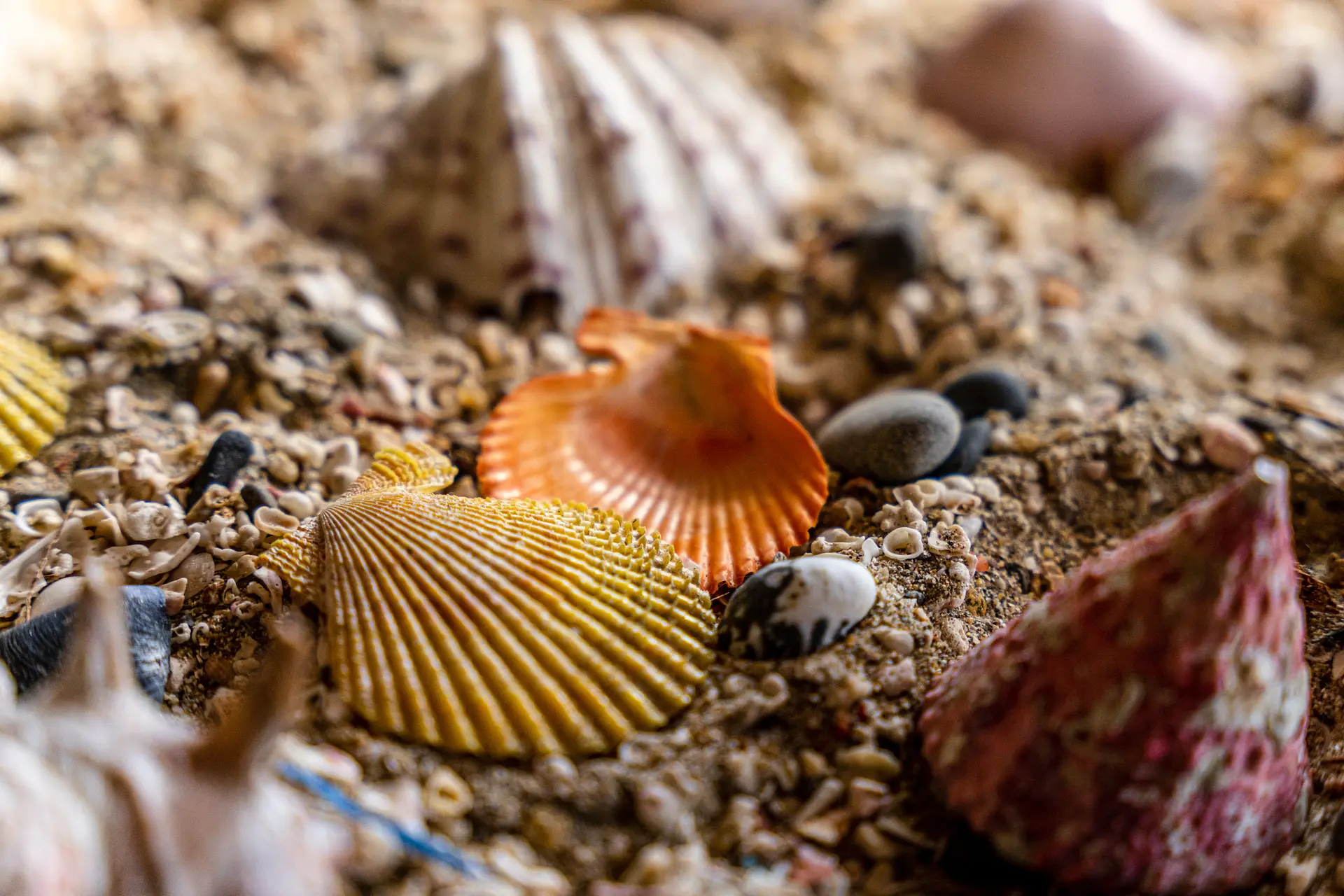
ちなみにこのカラフルな貝殻の名前は桧扇貝(ヒオウギガイ)といって、さとうみ庵内でディスプレイにも使われています。見た目の可愛さはもちろん、お味もGOODですよ!
海女小屋にて、海女さんが目の前で網焼き!
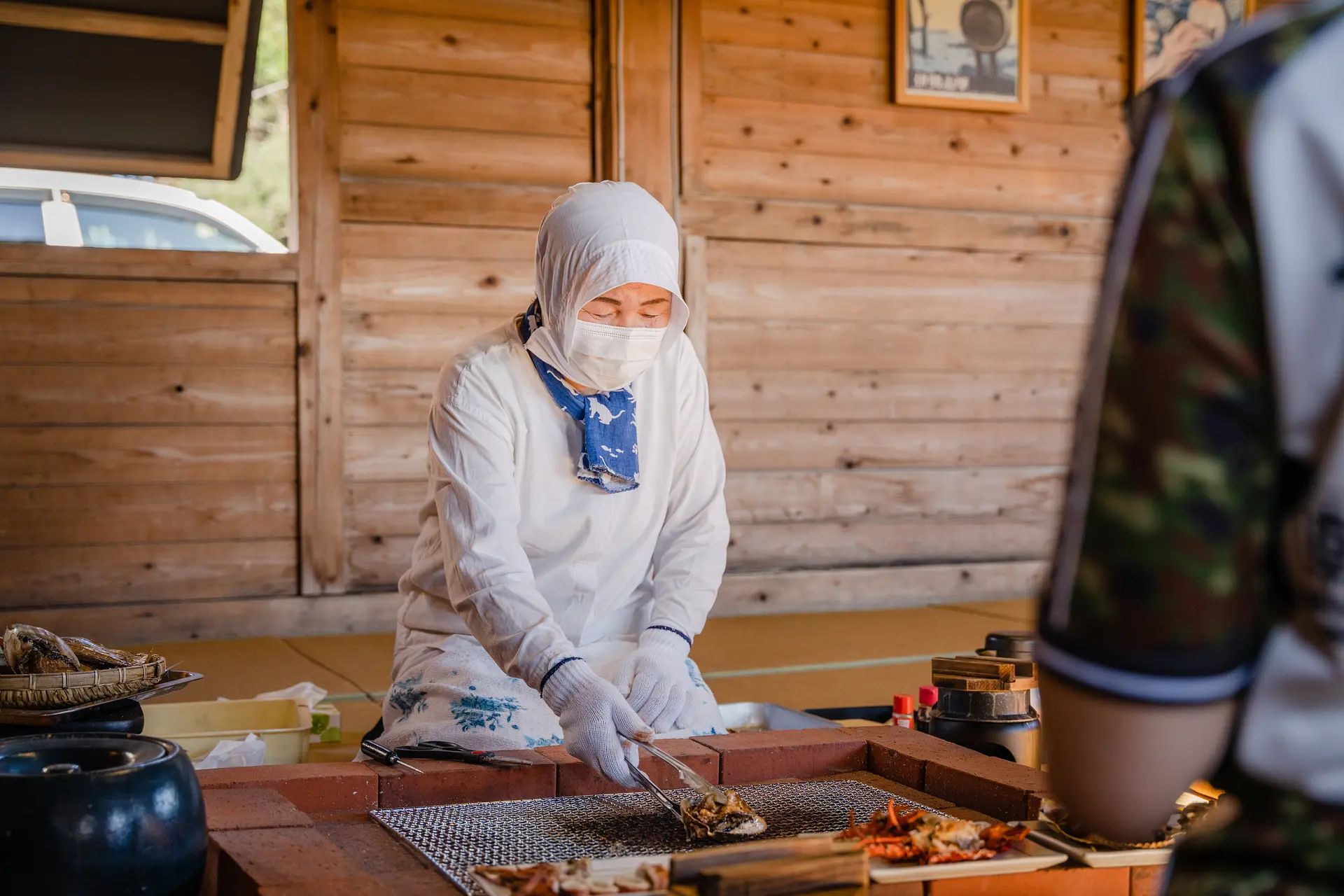
本来の海女小屋同様、畳にかまどが備え付けられた部屋にて、目の前で海女さんが海産物を焼いてくれます。今回焼いてくれるのは現役海女の林喜美代さん。海女漁や海の話を聞きながら楽しむ食事は、なんとも贅沢です。
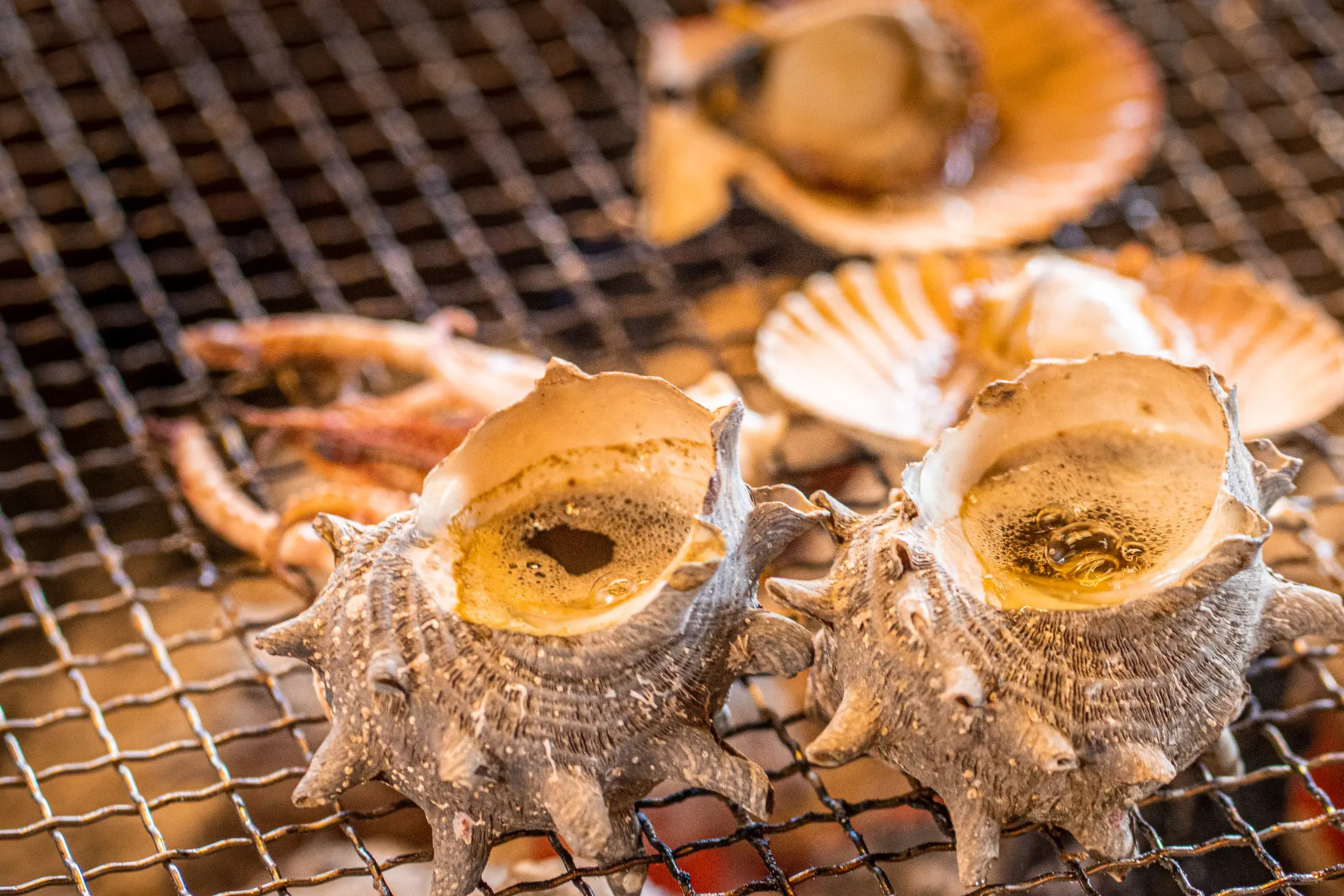
グツグツ、ジュウジュウ…と海産物が音を立てて焼き上がり、ふんわり香ばしい匂いが漂ってきました。
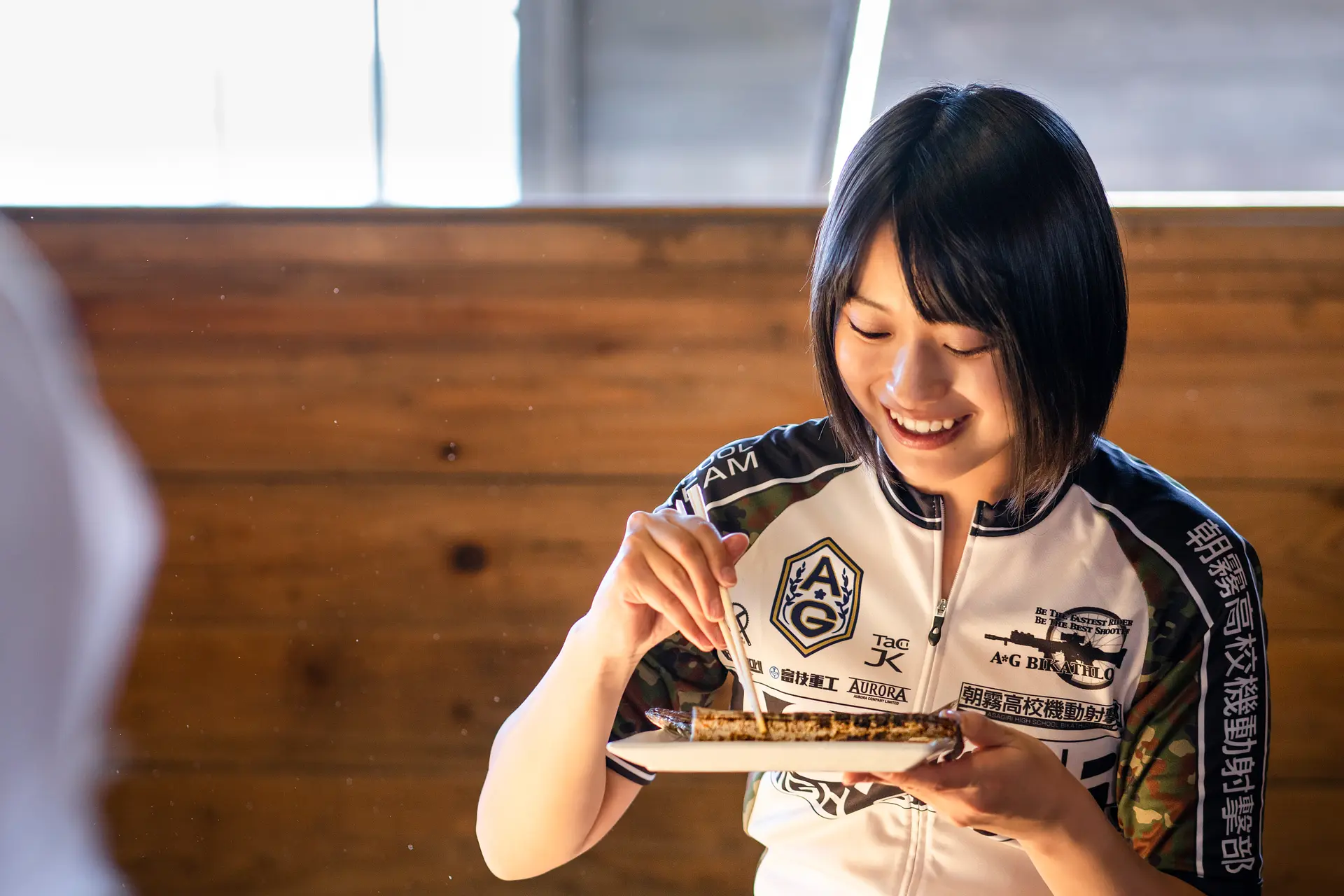
志摩でのサイクリングを楽しんだ後ということもあり、お腹ぺこぺこなかざりさん。海女さんが焼いてくれた海産物をいただきます♪「新鮮な海の幸、最高です!」と幸せそうな笑顔。おいしそう~!
伊勢えび漁、解禁!
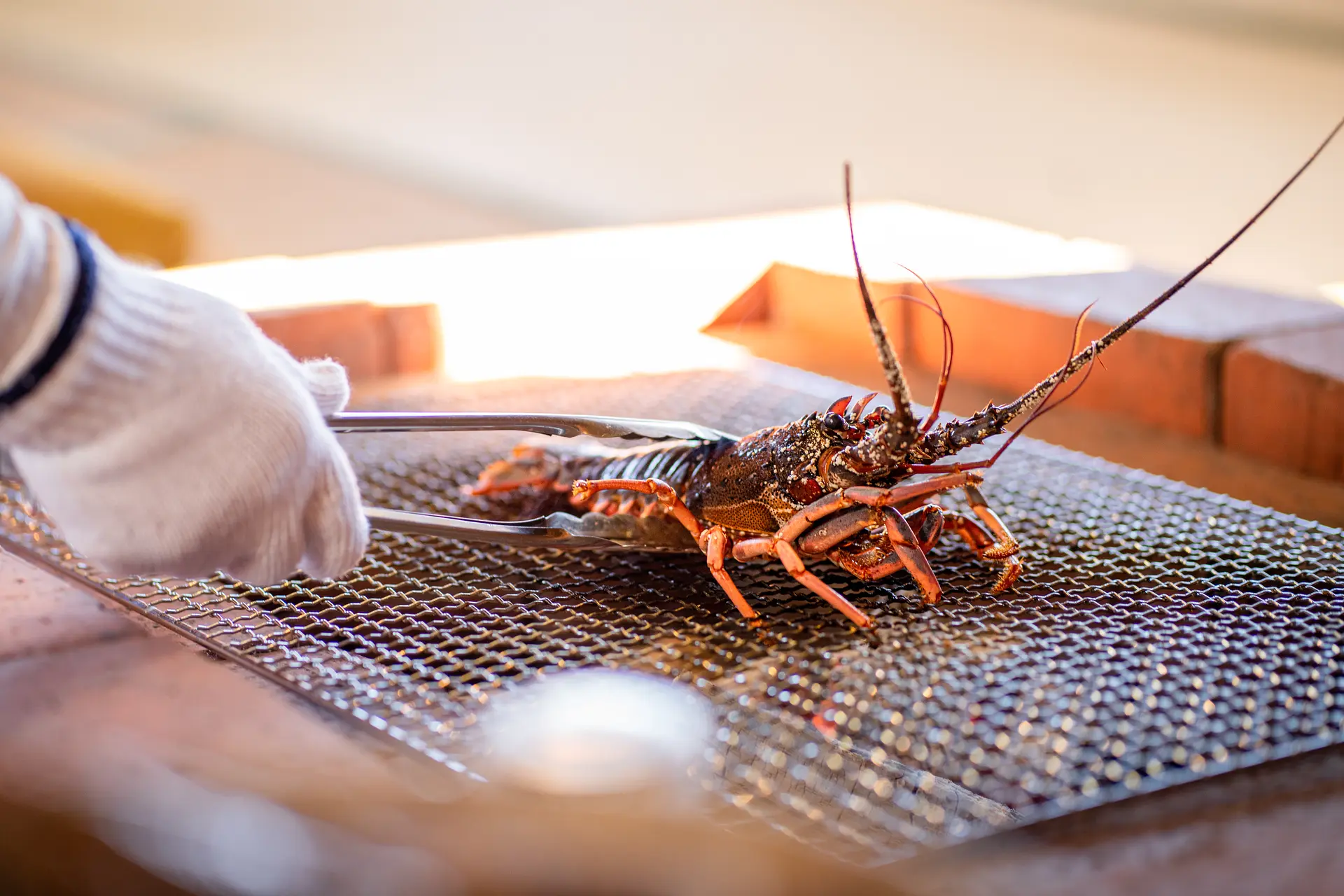
10月より伊勢えび漁が本格的に解禁され、海女小屋体験施設さとうみ庵でも食べられる時期がやってきました♪「伊勢えびは、主に刺し網漁といって夜に網をしかけて採るんですよ」と海女の林さんに教えてもらいました。伊勢えび漁の話もしながら、大きな伊勢えびを丸ごと一匹、網の上で焼いていきます。
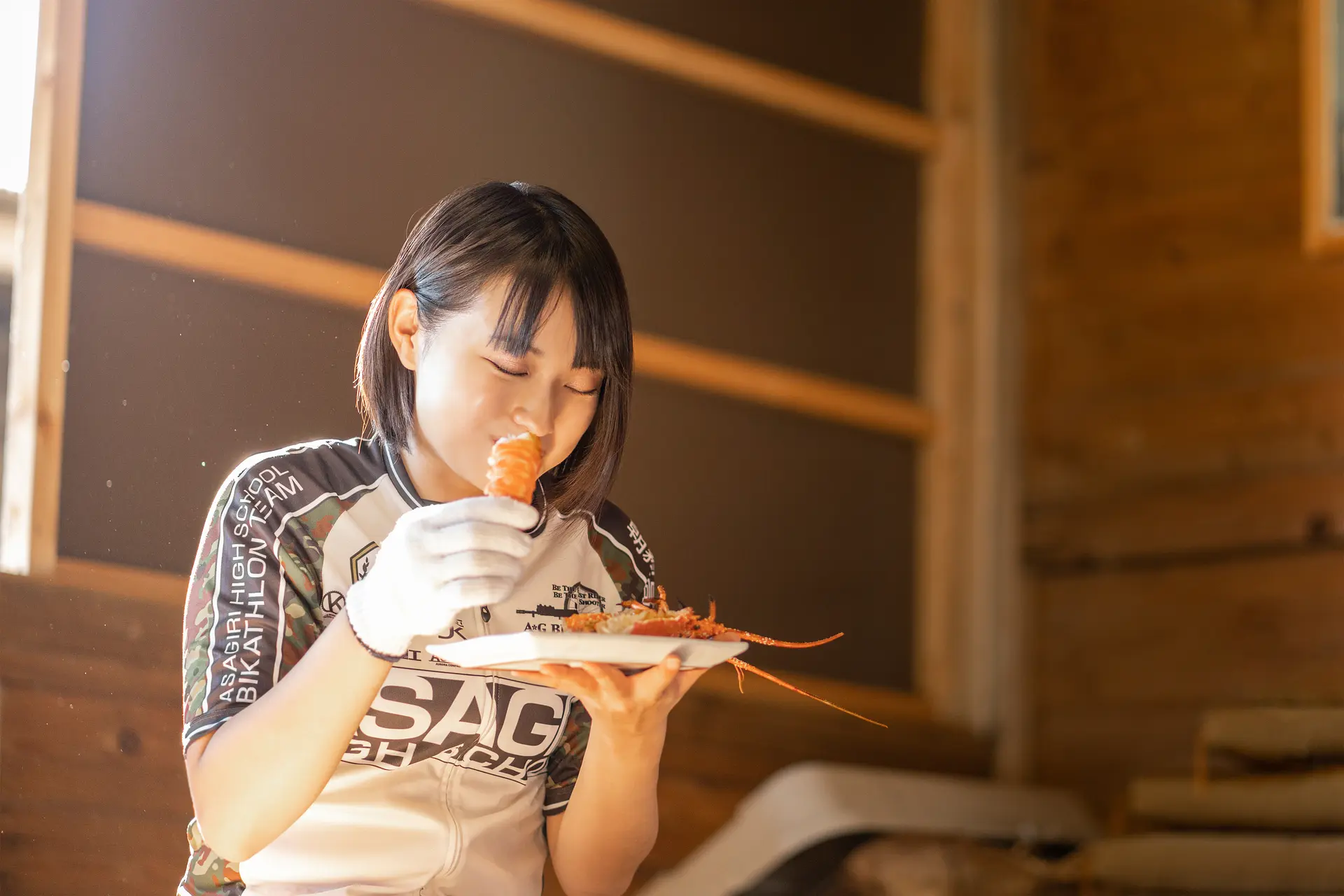
伊勢えびのみそをたっぷり付けて、ぷりぷりの身を、ばくっと頬張るかざりさん。「おいしい~~~~!こんな豪華な食べ方、いいんでしょうか?!」と豪快な伊勢えびの食べ方に、驚きつつも感動のご様子。
3.本物の海女さんにいろいろ聞いてみよう!
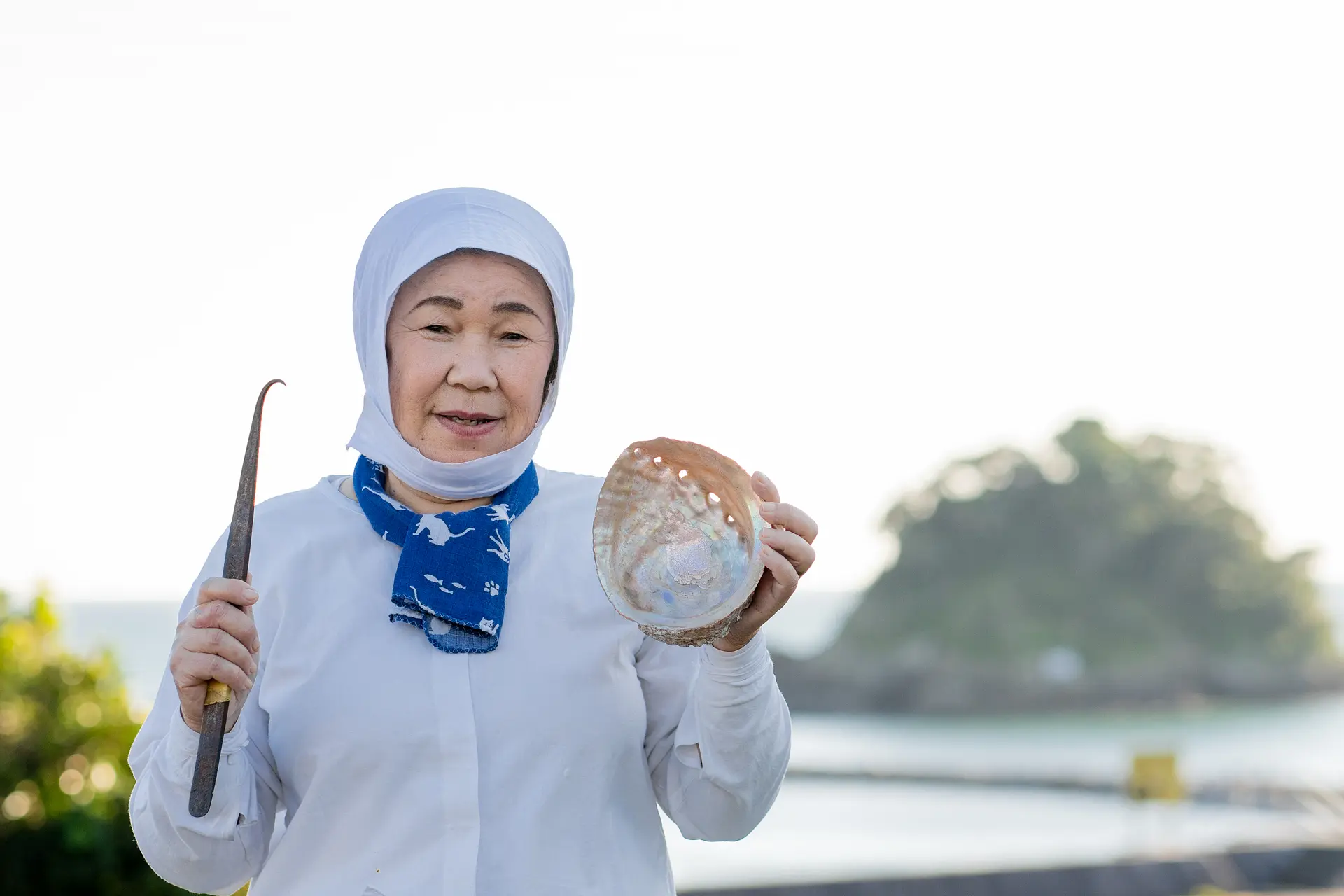
美味しい海産物をいただいた後、さとうみ庵で活躍する現役海女の林さんに、海女さんになったきっかけや、現在の志摩の海女さんの活動状況など、いろいろ聞いてみました!
林さんの海女歴
林さんは15歳から海女業をスタートし、なんと現在52年目。母も祖母も海女さんで、林さんご自身は「アメリカにあるテーマパークで観光海女の募集があったので応募し、2年間勤めました」とのこと。海女さんがアメリカでパフォーマンス?!めちゃめちゃグローバルです…。
帰国後は和歌山県の温泉施設で観光海女を12年続け、志摩市にUターン。「今も現役です!海女は大好きな仕事なのでずっと続けられますね」と語る林さん、「今まで風邪をひいたことがないんです。ちょっと体調が悪くても海に潜れば治っちゃう。私にとっては海が薬です」と朗らかに話してくださいました。
海女が少なくなってきている
「現在志摩市の海女は24名ほど。昔は1つの海女小屋に10人くらいいるのが当たり前でしたが、今では1~2人ずつくらい」と志摩市の海女の現状を話してくださいました。2007年頃400人以上いた志摩市の海女さんたちは、年々大幅に減ってきています。「さとうみ庵の海女小屋体験を通じて、海女文化を一人でも多くの人に知っていただけけると嬉しいです」と林さん。
「ちなみに24名のうち14名が男性で、女性の方が少ない状況です」とのこと。なお男性の場合、海の武士と書いて「海士(あま)」と呼ぶそう。「今はウェットスーツを着るようになったので、男性も海士ができるようになりました。昔の磯着だとかなり寒いので、皮下脂肪が比較的多いとされる女性の方が海女に向いていたんです」とのこと。なるほど。
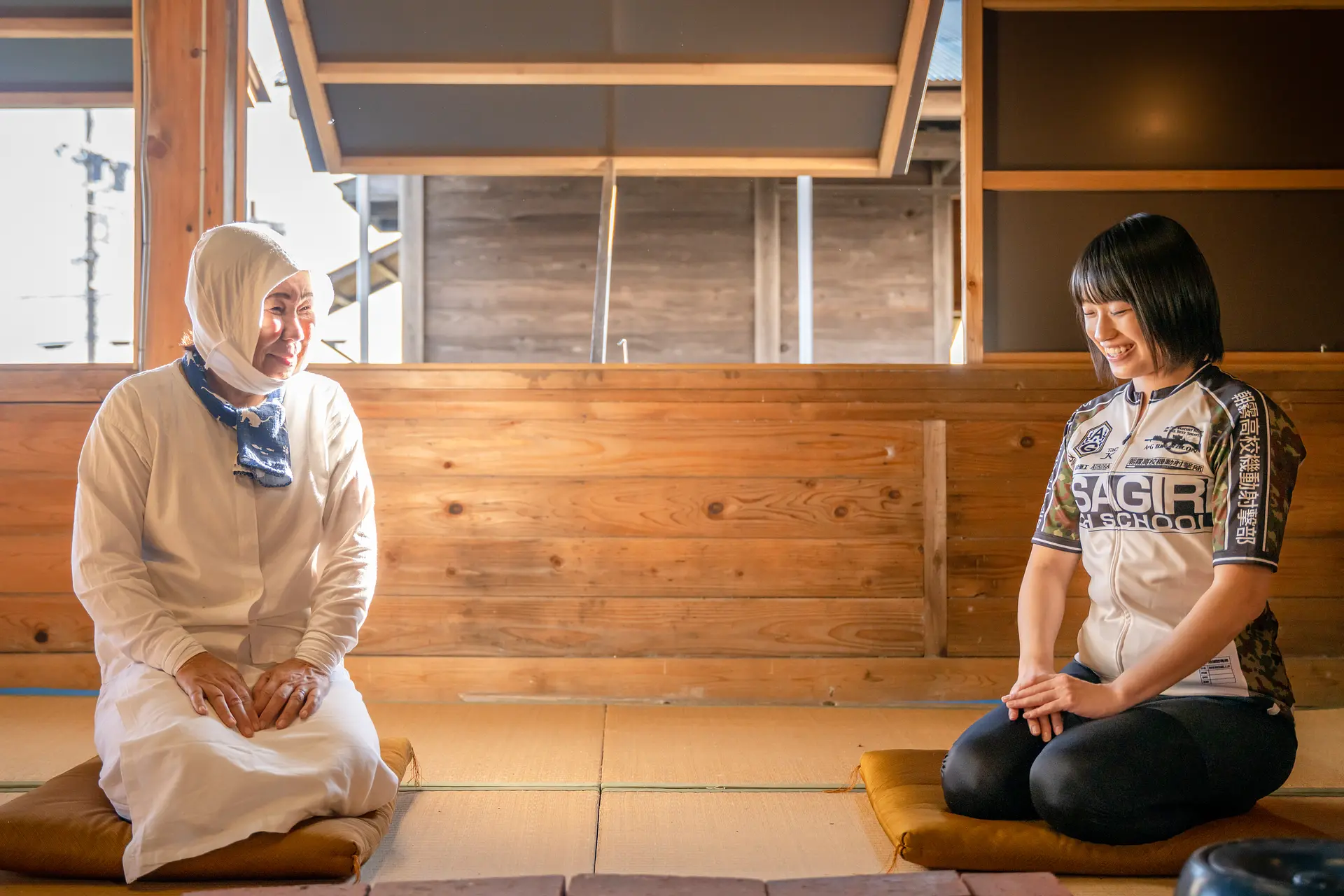
かざりさん「林さんのお話を通して海女文化についてたくさん知ることができました。貴重なお話、ありがとうございました!」
4.最後に海女の服、磯着を着てみよう!
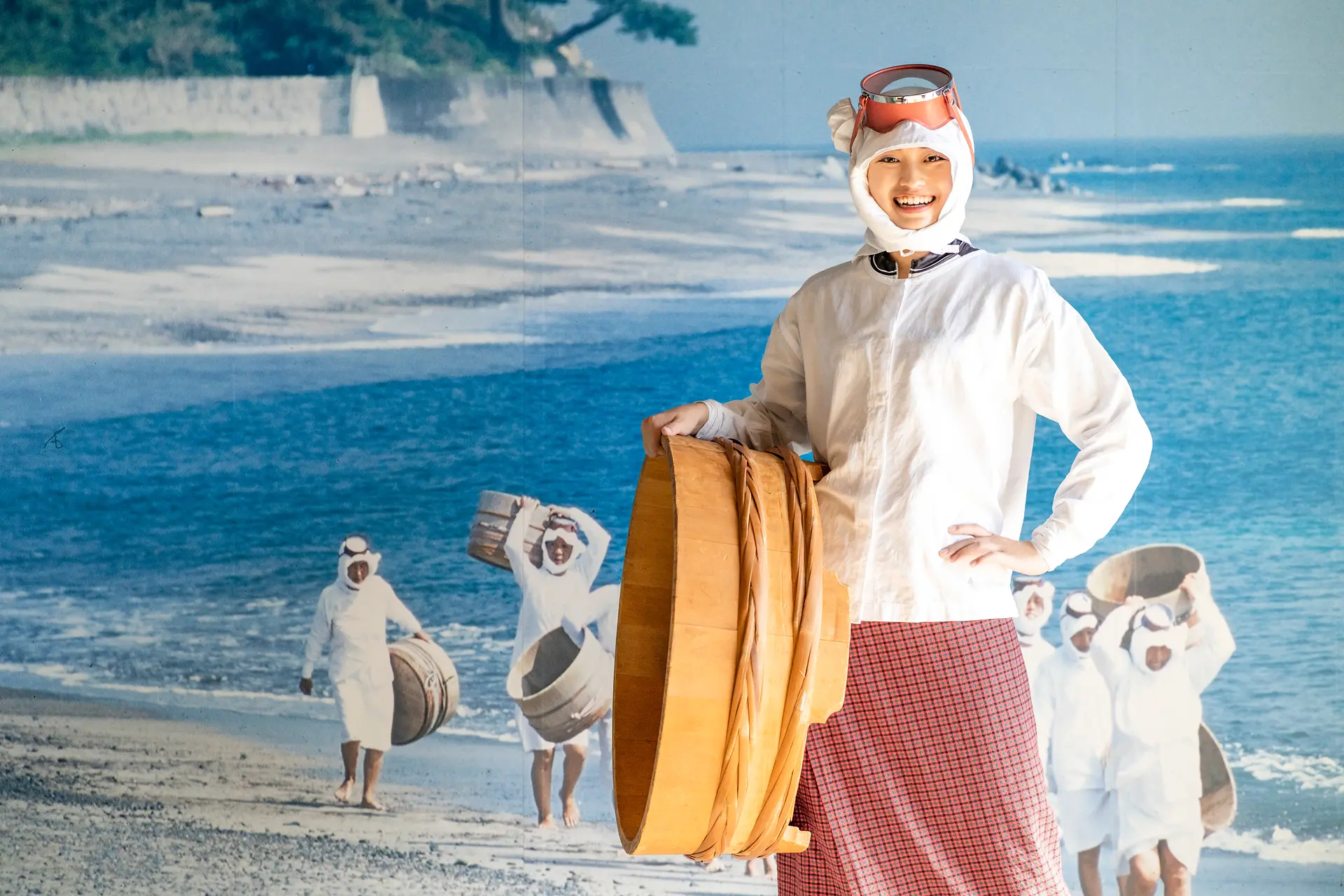
海女小屋体験施設さとうみ庵では、伝統的な海女さんの服装、「磯着」を身に着ける体験ができます!磯着に磯メガネ、磯桶を抱えてポーズを決めてくれました。笑顔がまぶしいです!
今回の任務を楽しんでいる様子が、YouTube動画で公開されています。ぜひご覧ください★
今回の志摩旅の任務を詳細にレポート。↓の記事もご覧ください♪
“ビアンキbianchi”でサイクリング♪志摩のお勧め絶景スポットを巡る!
「志摩地中海村」は宿泊でも日帰りでも楽しい♪海外旅行気分で街を巡ろう!
ドーム型テントが新設!「ラグナ伊勢志摩LUXUNA」でグランピングを満喫!
5.海女小屋体験施設さとうみ庵へのアクセス
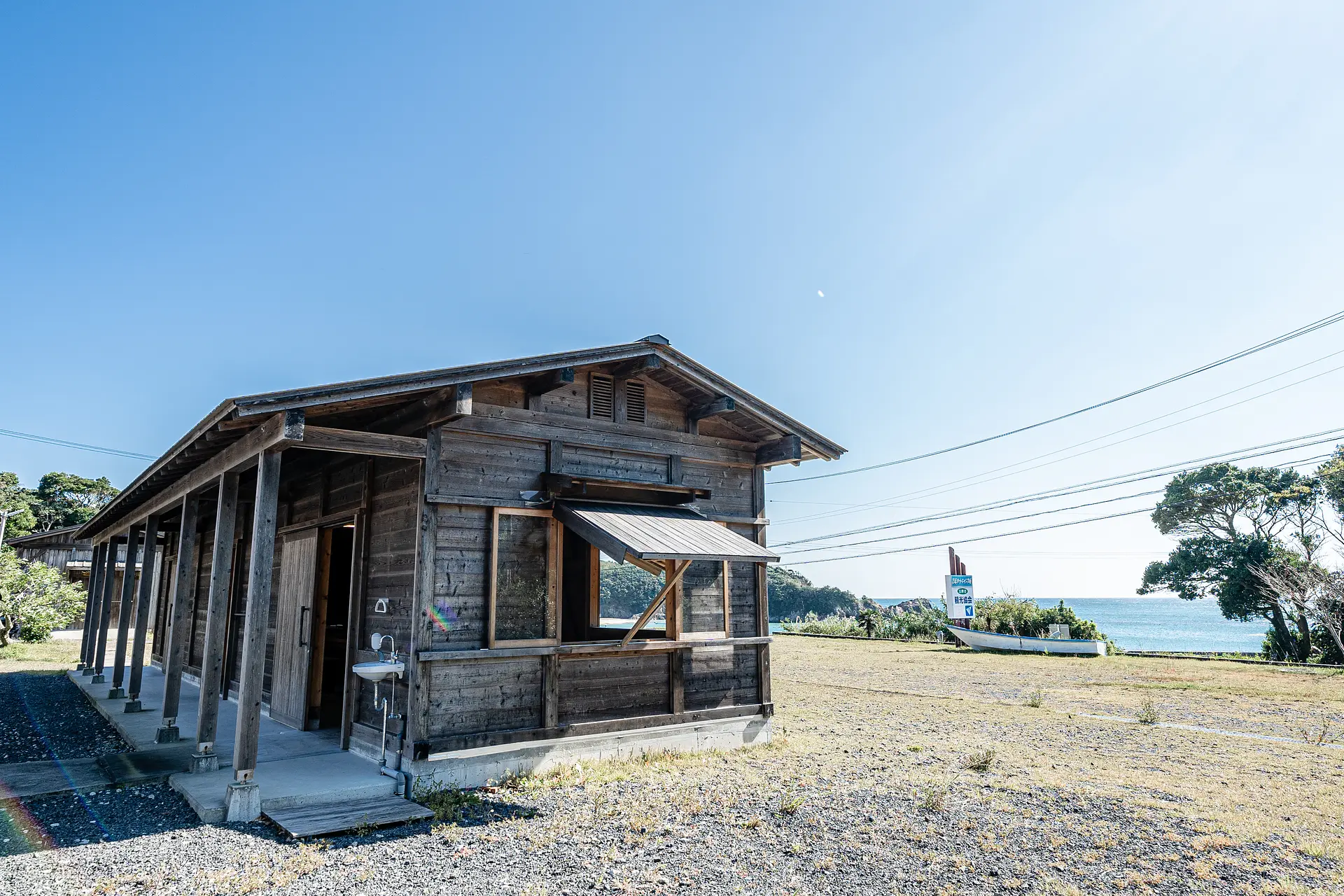
海女小屋体験施設さとうみ庵
基本料金:一人3,850円(税込)(3名様~)
●ぷりぷり桧扇貝(2個)
●採れたてさざえ(1個)
●新鮮スルメイカ(1杯)
●漁師町の干物(2種類)
●名物青さのお味噌汁
●ひじきの釜飯
【オプショナルプラン】
伊勢えび(10月~4月)
あわび(3月~9月)
地元名物てこね寿司 3人前より 2,750円~(税込) ※要予約(2日前まで)
完全予約制
※詳細はHP(http://satoumian.com/)もしくは海女小屋体験施設さとうみ庵TEL(0599-85-1212)まで
11:00~20:30(L.O.19:00)
所要時間:約90分
年末年始(2022年12月30日~2023年1月1日)
2023年1月10日~1月11日
※その他、臨時休業はお知らせにてご案内します
有
近鉄鵜方駅より三重交通「御座港」行きバスにて約60分、「あづり浜」バス停下車徒歩すぐ

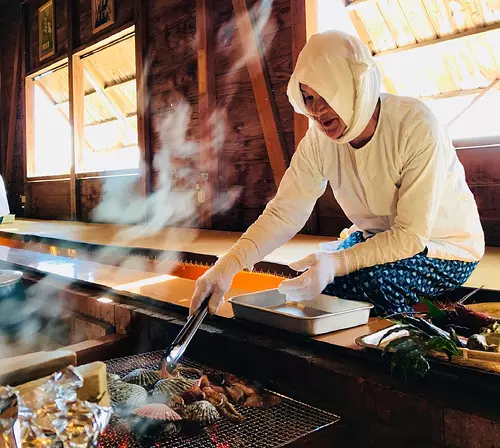
.png)
